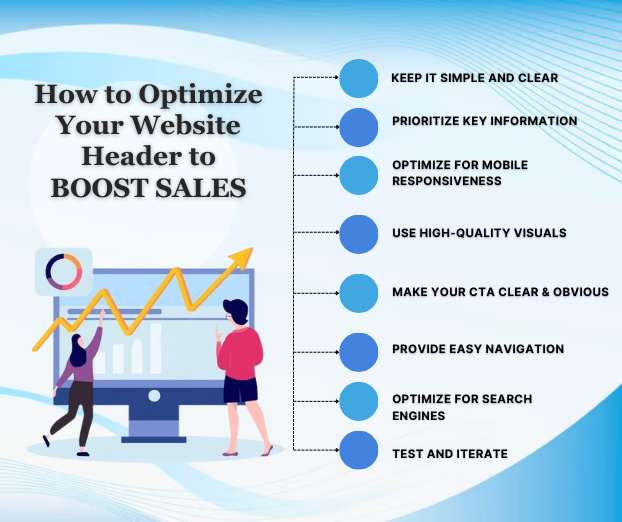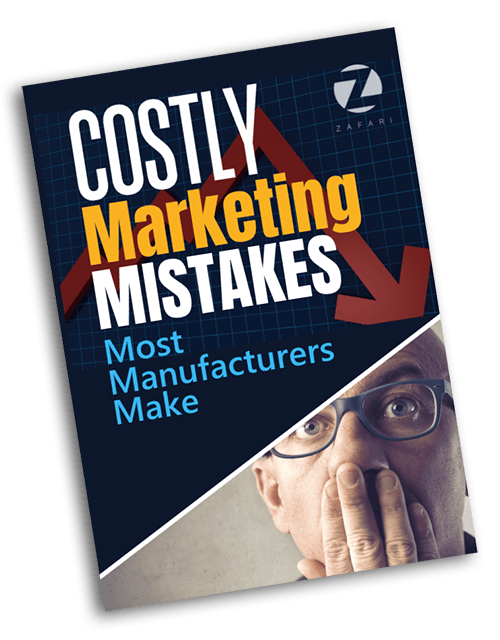Is Your Website Header Costing You Sales?
The website header refers to the top section of any web page that’s ‘above the fold’ – that’s the portion that is immediately visible before any scrolling. Think of it like the headline of a newspaper on a newsstand that’s visible before you pick it up. It’s what makes you want to buy the newspaper!

A website header is generally a combination of text and visuals. It should tell visitors the most important things about your business. But a poorly designed or complicated website header can cost you sales. This is because such headers can confuse visitors. As a result, it will be challenging for them to understand what your website is about or where to seek the information they are looking for. This confusion can cause frustration and ultimately make them leave your site without making a purchase or taking any action to engage with your brand. To assess this, put yourself in the shoes of your target audience and carefully examine your website header.
Ask yourself:
- Does it pass the “grunt test”? That means does it immediately answer these three critical questions:
- What do you offer?
- How will it make my life better?
- How do I get it?
- Is the language easy to understand for my audience?
- Have I minimized the use of technical jargon?
- Are CTA buttons placed prominently?
- Are the visuals enhancing or distracting from the message?
By critically assessing these aspects, you can determine whether your website header is effectively contributing to your sales efforts.
Why You Need to Optimize Your Website Header Right Now
Back to our newspaper example, if the newspaper had tiny text all the same size and nothing was larger or bolded, it would be impossible to get an idea of what was contained inside without a lot of effort. And nobody is going to do that! If your website header is cluttered or confusing, customers may struggle to understand what you offer and quickly lose interest. They’ll move on and you’ve just lost a golden opportunity to engage with them. Therefore, you should optimize your website header to ensure that it communicates your brand’s message, offerings, and key information at a quick glance. A clear and appealing header helps improve user experience.
How to Optimize Your Website Header to Boost Sales

Keep it Simple and Clear:
The golden rule of website headers is simplicity. Avoid cluttering the header with excessive text or graphics. Instead, convey your message using clear and concise language to explain what you offer and how it will help the end customer. One big step you can take in this direction is to minimize the use of unnecessary jargon or technical terms. Keep in mind that not all of your potential customers are familiar with your industrial language. For better clarity, here are two examples of a pipe-cutting tool website header. Example 1 (Simple and Clear): High-Quality Pipe-Cutting Tools Proven to Boost Productivity Efficient • Precise • Reliable Example 2 (Complex and Unclear): Welcome to PipeCut Pro – Founded in 1945 in Toledo, Ohio – Your Leading Supplier of Cutting-Edge Pipe Cutting Solutions Harness the Power of Our State-of-the-Art Technology and Precision Engineering to Enhance Your Operational Efficiency Check Out our Extensive Portfolio of Innovative Tools Engineered to Deliver Unmatched Performance and Productivity In this scenario, example 1 is much easier for a visitor to scan and understand than example 2. Most visitors will not read most complex text and including it risks the chance they won’t read ANY of it.
Prioritize Key Information:
Make sure your website header displays essential information about the page. For example, a home page should convey key information about the brand’s offerings and value to the customer. Likewise, a product page should highlight the top benefits of the targeted product in its header. Don’t forget to add a clear call to action [or CTA] button in a prominent location and bright color to encourage visitors take the required action.
Optimize for Mobile Responsiveness:
What does your website header look like when it is opened on a mobile phone or tablet? This is a crucial point to consider as over 90% of customers are likely to access web content with their mobile phones. That’s why it is important to ensure your website is mobile responsive. This means designing a website that looks good on all screens and resolutions. It provides a consistent user experience across all devices. A mobile-friendly header not only enhances usability but also improves search engine rankings, as Google prioritizes mobile-friendly websites in its search results.
Use High-Quality Visuals:
Visual elements such as images and graphics play a vital role in capturing visitors’ attention and conveying your brand identity. Invest in high-quality visuals that reflect the professionalism and credibility of your business, preferably custom shots and video rather than generic stock photography, videography or graphics. Whether it’s a striking hero image or a captivating background video, choose visuals that resonate with your target audience. For example, you can use visuals showcasing a CNC machine’s intricate parts or close-ups of precision-engineered parts. And you can showcase your tool’s performance in real-world scenarios.
Incorporate Branding Elements:
Your website header lets you reinforce your brand identity and create a memorable impression. Incorporate branding elements such as your logo, brand colors, and typography into the header design. Consistency is key here—ensure that your header aligns with the overall aesthetic of your website and reflects your brand’s personality and values.
Provide Clear Navigation:
A well-organized navigation menu with no more than 8 high-level choices is important for guiding visitors through your website. It helps them find what they are seeking quickly. Therefore, your menu structure should be simple and intuitive. Consider incorporating dropdown menus or mega-menus for sites to give easy access to a large number of pages or categories.
Optimize for Search Engines:
Your website is meant for human visitors. But what gets your website in front of human visitors is often a search engine. That’s why the header should be SEO-friendly along with other elements on the website. Include relevant keywords in your header text and image alt tags to improve visibility in search engine results. Additionally, make sure your header code is clean and optimized for fast loading times, as page speed is an important ranking factor for search engines. It’s very important to strike a balance between clear and concise language for the human visitor and meaningful search terms for the search engines.
Test and Iterate:
Conduct A/B tests to compare different header variations and identify which elements resonate most with your audience. Use this data-driven approach to iterate and refine your header design over time.
OVER TO YOU…
Incorporating or considering all the things said in this blog will lead to a clean, simple yet effective website header. Your website header serves as your initial introduction to your business and its offerings to potential customers. It not only encourages visitors to delve deeper into your website but also has the potential to drive sales and propel your business forward.





